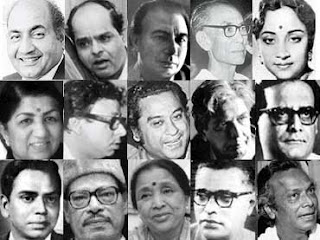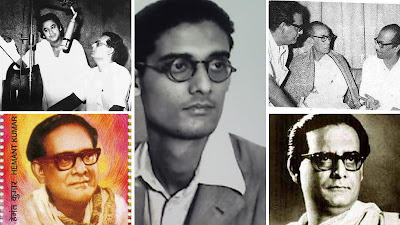PART 1 OF 10: GIRL POWER
The songs that I will feature in this series are in chronological order, except for the first one. I will start with the year 1959. Nehru was still the premier of India. His rose-tinted 'Hindi Chini bhai bhai' vision would continue on for another three years, till it received a severe jolt with the Chinese invasion. The Dalai Lama had fled to India and Fidel Castro was anointed the Prime Minister of Cuba early that year. Nepal's women voted for the very first time in election, while Swiss women were denied suffrage in a referendum vote (they would finally get the right to vote in 1971).
The first song in the series is from the movie, 'Dil Deke Dekho' starring Shammi Kapoor and Asha Parekh (her debut), with Nasir Husain helming the direction department - it was just his second movie. There is the eponymously titled number sung by Rafi that is perhaps more famous than the one I am going to play.
I have a reason why I featured this song first. In the quarter century that I looked at for this series, the Hindi film industry produced nearly two-thousand three hundred movies. There were over three hundred people that held the baton as music composers for these films.
Add to that the hundreds of male and female singers that sang these tunes and twice that number of actors and actresses that lip-synched and danced to those songs. It is a reflection of the plenteous musical talent in the country then. Films in India offered opportunities to women, almost on par with men, that no other occupation did. But, here is a sobering statistic. Guess how many female music directors made that list of three hundred. Two. Yes, just two. One was Saraswati Devi, who was the senior one and was the composer for just two movies during this period (she did scores of movies - excuse the pun - during the 1930s and 40s). The other one was Usha Khanna. Usha was perhaps the only one that broke the musical glass ceiling and donned the role of music composer for over one hundred and fifty movies spanning four decades. It is a puzzle if you look at it. A field such as film music that has produced such giants among women, when it came to playback singing, was (and still is) underrepresented in the music direction department. That makes Usha Khanna's achievement all the more incredible.But neither Saraswati Devi nor Usha was the first female music director of India. That privilege went to a person by named Jaddanbai - the incredibly talented, multi-faceted, courtesan-turned-Ghazal-singer-turned movie maker, actor, and music director. Her daughter was the famous actress Nargis Dutt, the superstar of the fifties and sixties.
Usha Khanna’s father, Manohar Khanna, hailed from Gwalior and was a government employee. He was a poet by night and wrote lyrics for Hindi films. He worked quite frequently with Jaddanbai and that’s perhaps how his daughter got interested in music. It was OP Nayyar and Sashadhar Mukherjee (the Mukherjee patriarch and actress Kajol’s grandad) that introduced Usha to music direction and 'Dil Deka Dekho', which was produced by Mukherjee, happened. 'Hum aur tum aur yeh sama' is sung like a dream by Mohammad Rafi, and the soothingly romantic lyrics are penned by Majrooh Sultanpuri.
It would be grossly unfair if I proceed with this song without tipping my head sideways to the King of Dance and Swag, Shamsher Raj Kapoor aka Shammi Kapoor. We will talk about the Kapoor Khandaan in a short while and I don't want Shammi to steal the thunder from under his dad and elder brother, because he is quite capable of it.
One could argue Shammi Kapoor never achieved the astronomical success that his elder brother, Raj, did. But if he had continued on the path of his 1953 debut, the resounding dud, 'Jeevan Jyoti', it would have been a surefire path to self-destruction and a life of anonymity lived in the monstrous shadows of his illustrious elder brother and father. We would have perhaps known him as another of the boisterous fat uncles from the photos of a Kapoor shaadi from an old copy of 'Cine Blitz' or from Kareena Kapoor's Twitter handle. Instead, Shammi Kapoor reinvented himself brilliantly.
After years of playing second fiddle to Madhubala, Nutan, and Nalini Jaywant, he lubricated the joints and screws in his already pliant body, donned a demeanor full of attitude, and treaded on a distinct path from his brother and the mainstream heroes of that time. He immediately hit box office gold with Nasir Hussain's debut, 'Tumsa nahin dekha' (1957) and with that India got its first romcom hero. Every hero after that had to don the Shammi Kapoor look and twinkle his eyes to woo his heroine. You could already see the quirky moves in the songs 'Jawaniyaan yeh mast mast bin piye' or the title song 'Yun to humne laakh hansin dekhe hain' in 'Tumsa nahin dekha'. By the time he acted in his first color film, 'Junglee' (1961), the bugger was totally out of control!
If you want to see a clearer clip, please click on the link below:
https://einthusan.tv/movie-clip/watch/music-video/none/cpggbNyrua/?lang=hindi








Comments
Post a Comment